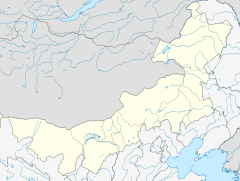
Back وهاي Arabic Ŭ-hāi (chê) CDO Wuhai (kapital sa prepektura sa Pangmasang Republika sa Tśina) CEB Wu-chaj Czech Wuhai Danish Wuhai German Vuhajo Esperanto Wuhai Spanish Wuhai Estonian Wuhai Basque
Wuhai
乌海市 • ᠦᠬᠠᠢ ᠬᠣᠲᠠ | |
|---|---|
 Cityscape of Wuhai | |
 Location of Wuhai City jurisdiction in Inner Mongolia | |
| Coordinates (Wuhai municipal government): 39°39′18″N 106°47′38″E / 39.655°N 106.794°E | |
| Country | People's Republic of China |
| Region | Inner Mongolia |
| Area | |
| 1,754 km2 (677 sq mi) | |
| • Urban (2017)[2] | 67.17 km2 (25.93 sq mi) |
| Elevation | 1,150 m (3,770 ft) |
| Population (2017)[2] | |
| 631,000 | |
| • Density | 360/km2 (930/sq mi) |
| • Urban | 550,000 |
| • Urban density | 8,200/km2 (21,000/sq mi) |
| Time zone | UTC+8 (China Standard) |
| ISO 3166 code | CN-NM-03 |
| GDP(2009) | 31.121B RMB |
| Website | www |
| Wuhai | |||||||||||||
|---|---|---|---|---|---|---|---|---|---|---|---|---|---|
| Chinese name | |||||||||||||
| Simplified Chinese | 乌海 | ||||||||||||
| Traditional Chinese | 烏海 | ||||||||||||
| Literal meaning | "Dark Sea" | ||||||||||||
| |||||||||||||
| Mongolian name | |||||||||||||
| Mongolian Cyrillic | Үхай хот | ||||||||||||
| Mongolian script | ᠦᠬᠠᠢ ᠬᠣᠲᠠ | ||||||||||||
| |||||||||||||
Wuhai (Chinese: 乌海市; Mongolian: ![]() Üqai qota, Mongolian cyrillic.Үхай хот) is a prefecture-level city and regional center in the Inner Mongolia Autonomous Region, China, and is by area the smallest prefecture-level division of the region. It is located on the Yellow River between the Gobi and Ordos deserts. Wuhai became a single city occupying both banks of the Yellow River with the amalgamation in 1976 of Wuda on the left (west) bank (then administrated by Bayan Nuur League) together with Haibowan on the right (east) bank (then administrated by Ikh Juu league). Wuhai is one of very few cities with an antipode which is not only on land (as opposed to open ocean), but which is another inhabited city; the antipode of Wuhai is almost exactly on the city of Valdivia, Chile. Football commentator and Television host Huang Jianxiang is born here.
Üqai qota, Mongolian cyrillic.Үхай хот) is a prefecture-level city and regional center in the Inner Mongolia Autonomous Region, China, and is by area the smallest prefecture-level division of the region. It is located on the Yellow River between the Gobi and Ordos deserts. Wuhai became a single city occupying both banks of the Yellow River with the amalgamation in 1976 of Wuda on the left (west) bank (then administrated by Bayan Nuur League) together with Haibowan on the right (east) bank (then administrated by Ikh Juu league). Wuhai is one of very few cities with an antipode which is not only on land (as opposed to open ocean), but which is another inhabited city; the antipode of Wuhai is almost exactly on the city of Valdivia, Chile. Football commentator and Television host Huang Jianxiang is born here.
- ^ Cox, W (2018). Demographia World Urban Areas. 14th Annual Edition (PDF). St. Louis: Demographia. p. 22.
- ^ a b Ministry of Housing and Urban-Rural Development, ed. (2019). China Urban Construction Statistical Yearbook 2017. Beijing: China Statistics Press. p. 46. Archived from the original on 18 June 2019. Retrieved 11 January 2020.
